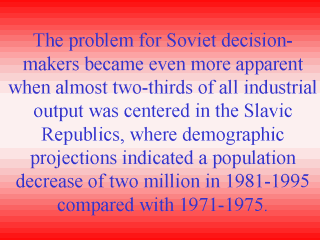 |
The rate of
growth in the Slavic industrial labor force was reduced from an average of 0.9 percent per
year during 1971-1985 to 0.5 percent per year in 1986-1990 (Feshbach, 1978). The size of
the available working-age population was projected to decline by more than one-fourth over
the 1990s and into the next century. This labor shortage coincided with a decrease of 2.8
percent in productivity between 1971-1975 and 1976-1980 (Feshbach, 1982b). There was a
decline in fertility, which resulted in a national population growth of only 0.4 percent
between 1980-1990, compared to the 1.8 percent growth in population during the 1960s. The
skilled labor pool was further reduced by the general aging of the population and the
rising mortality among males in the productive ages of 20-59 years. This labor pool, which
increased by 30 million in the working-age population during the period 1970-1985, was
already anticipated to shrink by 6 million between 1985-2000 (Baldwin, 1979). |
